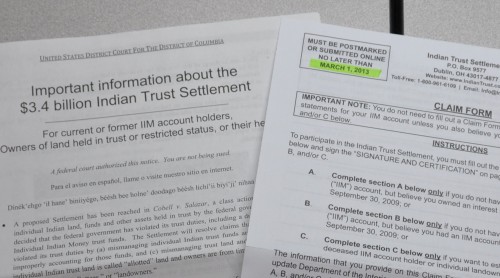By MATT VOLZ, Associated Press
HELENA, Montana — Laura Juarez is supposed to receive close to $1,200 as her share of a $3.4 billion settlement among hundreds of thousands of Native Americans whose land-trust royalties were mismanaged by the government for more than a century.
The Bakersfield, California, notary public was going to pool that money with her husband’s share, along with a portion of what was coming to her father’s estate, to send her 17-year-old daughter to a student-ambassador program in Australia.
But the money, which she expected in December, still hasn’t come and her daughter isn’t going on next month’s trip.
The payments have been held up by more than 2,400 appeals by people who were ruled ineligible to participate in the settlement. As the special master appointed to the case goes through those appeals, Juarez and other American Indians are growing increasingly frustrated over what they see as justice delayed.
“It seems as if the Native Americans are being screwed again,” said Juarez, a 39-year-old member of the Comanche nation. “I know several others who have given up on it. It’s created a sour taste in their mouths. We get our hopes up just to have it knocked down.”
The 493,724 beneficiaries identified as of the beginning of May already know how much they are supposed to receive from the settlement — the individual payments range from $850 to nearly $10 million — and many had earmarked those amounts to splurge on big purchases or simply pay their bills.
The delays have resulted in complaints to the claims administrator, an online petition and even a letter from Montana Sens. Jon Tester and John Walsh about a lack of transparency and misinformation regarding the payments.
“This delay is placing a financial burden on Montana families, and forcing many who are expecting payments to take out loans that they are now unable to repay,” the April 3 letter to the settlement’s claims administrator, Garden City Group, said.
Jennifer Keough, Garden City Group’s executive vice president and chief operating officer, did not return a call for comment.
The attorneys representing the plaintiffs in the class-action lawsuit, recognizing the frustration, plan to ask a federal judge this week to allow the distribution to take place before the appeals are finalized.
“The agreement says that no trust administration class payments can be made until all the members are identified,” said David Smith, an attorney for Kilpatrick, Townsend and Stockton LLP. “There are a lot of appeals, and many are extremely lengthy. We want to make sure everybody has a chance to participate in the settlement and it’s not a rush job.”
At issue is the second of two distributions in one of the largest U.S. government settlements in history, prompted by a lawsuit filed in 1996 by Blackfeet elder Elouise Cobell of Montana. Cobell sued the government after realizing that many Indians who owned land held in trust for them by the government lived in poverty with no accounting of the royalties they were due when the Interior Department leased their land for development, exploration or grazing.
The lawsuit claimed the Interior Department mismanaged and squandered billions of dollars that were supposed to go to the landowners since the 1880s, but incomplete and missing records prevented them from determining how much was lost.
It took about 14 years to reach a settlement with the government, then another year for Congress to approve the deal in December 2010. It wasn’t until December 2012 that all the appeals over the settlement were dismissed and the first monetary distributions were mailed.
Those 339,106 beneficiaries, called the historical accounting class, received a flat payment of $1,000 apiece. That was the easy part.
The second round of distributions go to what is called the trust administration class in varying amounts based on a formula that looks at 10 years of the highest earnings in the royalty accounts held by the government, which are called Individual Indian Money trust accounts.
Identifying the people in that second class — which also contains members of the first class — has proven to be a challenge due in part to the Interior Department’s incomplete record-keeping, Smith said. For example, the Interior Department had no records for thousands of people in Oklahoma who had made claims, leading to an extension of the appeals period while they tried to prove their claims by going to the state courts for documentation.
Plus, there were no known addresses for 65,000 people identified as beneficiaries, which Garden City Group has been able to whittle down to about 14,000, Smith said.
The search for those still on the list continues, though it won’t hold up the payments, he said.
That’s little consolation to the beneficiaries who are waiting. Not only are their payments delayed, but their checks are diluted when more class members are added.
In Juarez’s case, she was told last summer she would receive $1,260. As of February, that had been reduced to $1,197 with the addition of more beneficiaries.
“If they’re entitled to that money, that’s great — awesome — but the timing is taking way too long,” Juarez said. “A deadline is a deadline. They are holding up so many people.”
